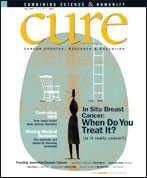Publication
Article
CURE
A Worry-Free Way to Support Nonprofits?
Author(s):
Such product advertising through the use of a nonprofit’s name is known as “cause-related marketing”—and these arrangements are on the rise. This year, U.S. companies will spend $1.34 billion on cause-related marketing, up from $1.17 billion last year, according to IEG, a Chicago-based marketing firm specializing in sponsorship. One of the earliest examples is American Express’s 1983 support of the Statute of Liberty restoration.
In a perfectly executed cause-marketing arrangement, everyone wins. The organization benefits by way of a budget boost and expanded exposure, while the company profits by being associated with a trusted organization and a good cause—endearing themselves to current and potential customers, which results in an increase of sales.
In many cases, the consumer of cause-related marketing also wins—as does the public at large. Individuals can easily put money where their heart is, and the infusion of funds helps the organization increase public education and advance medical research or policy advocacy, says Jeff Manning, manager of corporate relationships for the Lance Armstrong Foundation. “Not everyone is great about returning direct mail, and nonprofits are always looking for creative ways to help people looking to support their mission,” he says. “Cause marketing is a great way to do that.”
But when donation-dependent charities and for-profits meet, there is an inherent danger of the giver’s interests influencing that of the receiver, warns Michael Jacobson, executive director of the Center for Science in the Public Interest, a Washington, D.C. consumer advocacy organization. “Industry funding is very tempting because it often comes in big bundles,” Jacobson says. “In some cases there is no problem at all, like if a mattress company gave $1 million to the American Cancer Society. But more typical is when a company closely related to the organization’s activity starts dangling gifts. Then the funding can influence an organization’s behavior in a number of ways.” The charity might feel obliged to promote the donor’s product, refrain from criticizing the donor’s product or activities, or compromise their mission to the betterment of the donor.
A blatant example of such behavior-altering funding: In 2003 the Coca-Cola Foundation gave $1 million to the American Academy of Pediatric Dentistry. The organization’s president at the time then denied any scientific evidence linking soft drinks to childhood oral disease—contradicting its earlier position on the subject.
But not all pitfalls of cause-related marketing are so obvious, Jacobson says. In the case of health nonprofits, consumers should be wary of the abundance of pharmaceutical donations, which can influence an organization to emphasize disease treatment over other issues, such as prevention or survivorship. “It’s impossible to quantify, but most independent observers would agree there is going to be an impact,” Jacobson says.
Cancer nonprofits interviewed for this story all say there are certain companies they refuse to partner with—mainly tobacco and alcohol makers. Marykate Wilson, cause marketing director for the American Cancer Society, says the organization’s “self-imposed rules of engagement” dictate that all of the organization’s 20 cause-related marketing partners meet strict criteria, including proper scientific review for medical products, clear messaging and proper government documentation.
The LAF’s Manning says the organization seeks out companies with a deep interest in its mission. This ensures a longer relationship, and sometimes an added marketing tool. Recently the foundation partnered with Chantal cookware, whose owner is a cancer survivor, to produce the LIVESTRONG by Chantal Collection.
Consumers should keep a few things in mind when putting their money with a cause-related marketing promotion, including the terms of the promotion—how much money from each sale goes to the nonprofit and what the money is used for—if there’s an educational component to the campaign and if the campaign resonates with individual beliefs and priorities.
Yoplait yogurt gives to the Susan G. Komen Breast Cancer Foundation, and you stock up the grocery cart with your favorite flavor. Nike supports the Lance Armstrong Foundation--and so you choose those sneakers over others.






